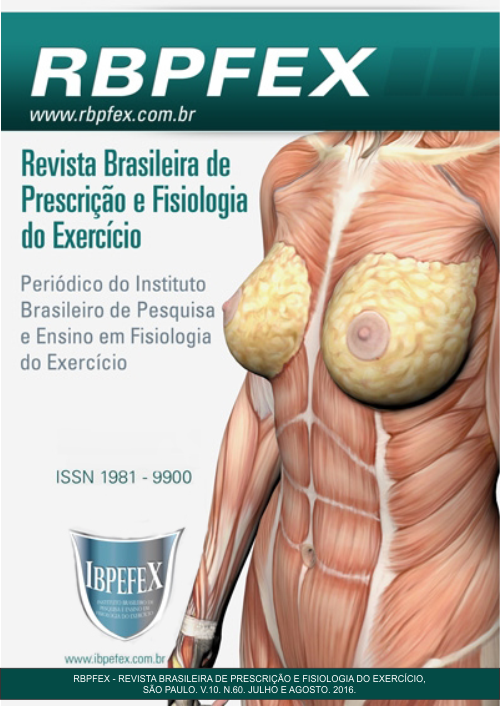Relationship between performance on running-based anaerobic test (rast) and the anthropometric's characteristic athletes of rink hockey
Abstract
Several tests have been developed to determine the anaerobic capacity and power of skeletal muscle in anaerobic energy transfer in the execution of different movements. However, few studies describe the use of these tests and their relationship to the physical characteristics of hockey players. Objective: To examine the anaerobic power hockey players and analyze their relationship with anthropometric indicators. Materials and Methods: We analyzed 14 athletes (27.0 ± 4.6 years old), belongingto affiliated clubs the Pernambuco Hockey Federation. The participants underwent anthropometric measurements (body mass and height), and were determined the body mass index (BMI) and Total Muscle Mass (TMM). To assess anaerobic power was used Running-based Anaerobic Test (RAST). To examine the relationship between anthropometric variables, anaerobic power (maximum, medium and minimum) and fatigue index (%), we used the correlation product-moment Person test. Results: Significant correlations were found between the minimum power, fatigue index and height (P<0.05). Other anthropometric indicators were not correlated with the maximal anaerobic power and mean (P>0.05). Conclusion: The maximum anaerobic power and average is not related to the anthropometric indicators BMI and TMM, however, these responses occur differently in relation to minimum power and other fractions associated with anaerobic power.
References
-American College of Sports,Armstrong, L. E.;Casa, D. J.;Millard-Stafford, M.;Moran, D. S.;Pyne, S. W.;Roberts, W. O.American College of Sports Medicine position stand. Exertional heat illness during training and competition. Med Sci Sports Exerc. Vol.39. Núm.3. p.556-572.2007.
-Asano, R.; Sales, M.; Moraes, J.; Coelho, J.; Botelho Neto, W.; Bartholomeu Neto, J.; Campbell, C.; Simões, H.Comparação da potência e capacidade anaeróbia em jogadores de diferentes categorias de futebol.Motricidade.Vol. 9. Núm. 1. p.5-12.2013.
-Bar-Or, O. The Wingate anaerobic test an update on methodology, reliability and validity. Sports Medicine.Vol. 4. Núm. 6. p.381-394.1987.
-Brázio, P. Estudo do processo ofensivo no Hóquei em Patins da Selecção de Portugal do Escalão Júnior, Dissertação de Mestrado na Faculdade de Desporto. Universidade do Porto. 2006.
-Dal Pupo, J.; Almeida, C. M. P.; Detanico, D.; Silva, J. F. D.; Guglielmo, L. G. A.; Santos, S. G. D. Potência muscular e capacidade de sprints repetidos em jogadores de futebol. Rev Bras Cineantropom Desempenho Hum. Vol. 12. Núm. 4. p. 255-261. 2010.
-Bertuzzi, R. C. M.; Silva, A. E. L.; Abad, C. C. C.; Pires, F.O. Metabolismo do lactato: uma revisão sobre a bioenergética e a fadiga muscular." Rev Bras Cineantropom Desempenho Hum. Vol. 11. Núm. 2. p. 226-234. 2009.
-Farlinger, C. M.; Kruisselbrink, L. D.; Fowles, J. R. Relationships to skating performancein competitive hockey players.The Journal of Strength & Conditioning Research. Vol. 21. Núm. 3. p. 915-922. 2007.
-Ferreira, P. V. M.H. Caracterização fisiológica de atletas portugueses de hóquei em patins de alto rendimento, Universidade de Lisboa. 2013.
-Gilenstam, K. M.; Thorsen, K.; Henriksson-Larsén, K. B. Physiological correlates of skating performance in women's and men's ice hockey. The Journal of Strength & Conditioning Research. Vol. 25. Núm. 8. p. 2133-2142. 2011.
-Lee, R. C.; Wang, Z.; Heo, M.; Ross, R.; Janssen, I.; Heymsfield, S. B.Total-body skeletal muscle mass: development and cross-validation of anthropometric prediction models. Am J Clin Nutr. Vol. 72. Núm. 3. p. 796-803. 2000.
-Marfell-Jones, M.; Stewart, A.; Ridder, J. International standards for anthropometric assessment. 2012.
-Martins, J. P. Perfil antropométrico do hoquista jovem português de elite. Federação Portuguesa de Patinagem. 2004.
-Nedeljkovic, A.; Mirkov, D. M.; Pazin, N.; Jaric, S. Evaluation of Margaria staircasetest: the effect of body size.European journal of applied physiology. Vol. 100. Núm. 1. p. 115-120. 2007.
-Nummela, A.; Alberts, M.; Rijntjes, R.; Luhtanen, P.; Rusko, H.Reliability and validity of the maximal anaerobic running test. International journal of sports medicine. Vol. 17. Núm. 2. p. S97. 1996.
-Plaza Balagué, D. Aplicació multiplataforma de resultats d'hoquei sobre patins. 2014.
-Potteiger, J. A.; Smith, D. L.; Maier, M. L.; Foster, T. S. Relationship between body composition, leg strength, anaerobic power, and on-ice skating performance in division I men's hockey athletes. The Journal of Strength & Conditioning Research. Vol. 24. Núm. 7. p. 1755-1762. 2010.
-Sabaté, R. Hockey Patines-preparación física. Alicante: Altorendimiento. 2009.
-Souza, J. D.; Gomes, A. C.; Leme, L.; Silva, S. G. D. Alterações em variáveis motoras e metabólicas induzidas pelo treinamento durante um macrociclo em jogadores de handebol. Rev Bras med esporte. Vol. 12. Núm. 3. p. 129-134. 2006.
-Zacharogiannis, E.; Paradisis, G.; Tziortzis, S.An evaluation of tests of anaerobic power and capacity. Medicine & Science in Sports & Exercise. Vol. 36. p. S116. 2004.
-Zagatto, A. M.; Beck, W. R.; Gobatto, C. A. Validity of the running anaerobic sprint test for assessing anaerobic power and predicting short-distance performances. J Strength Cond Res. Vol. 23. Núm. 6. p. 1820-1827. 2009.
Authors who publish in this journal agree to the following terms:
- Authors retain the copyright and grant the journal the right of first publication, with work simultaneously licensed under the Creative Commons Attribution License BY-NC which allows the sharing of the work with acknowledgment of the authorship of the work and initial publication in this journal.
- Authors are authorized to enter into additional contracts separately for non-exclusive distribution of the version of the work published in this journal (eg, publishing in institutional repository or book chapter), with acknowledgment of authorship and initial publication in this journal.
- Authors are allowed and encouraged to post and distribute their work online (eg, in institutional repositories or on their personal page) at any point before or during the editorial process, as this can bring about productive change as well as increase impact and impact. citation of published work (See The Effect of Free Access).






